How I developed a device for rocking a crib
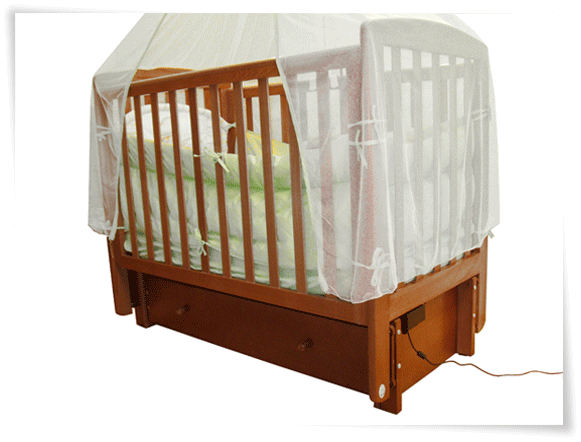
This article is about how I developed a device for swinging a crib with a pendulum mechanism.
If interested - welcome under cat.
This story began more than three years ago, when my wife and I were preparing for the birth of a son. Among other things, I attended to buying a baby crib, and began to explore the market on this topic. It turned out that today the following types of beds are sold:
- Just a bed, standing on his feet. Legs are usually equipped with wheels.
- Rocking bed with arcuate skid.
- Cot with pendulum swing mechanism.
Pendulum mechanisms are longitudinal (the bed swings along the long side, as in the title picture), transverse (the bed swings along the short side) or universal. In the latter case, the same bed can be assembled and so and so.
There are also cradles - a small cradle, which is convenient to put next to you when you do something, and the baby is awake.
')
There are still beds, Chinese. There are also transforming beds, a chest of drawers and a changing table attached to them from the butt, and there are also options with a pendulum. And a lot of what is exotic.
But I was tuned specifically to the traditional bed, standard sizes, made of birch or beech, with a pendulum swing mechanism. Well, as a “progressive man of advanced views,” I immediately thought that it’s not with my own hands to swing this bed. Surely, I thought, rocking mechanisms were invented long ago, you just have to go to the store and buy.
However, to my surprise, it was found that there is no ready-made device for sale. But there are tips. For example, to tie a rope to the foot with one end, and the other to the bed, and swing the bed to swing the leg. You can even sit at the computer. And you can tie a string to the CD-ROM table, and write a program that will open and close the table with some periodicity. And you can use the drive wiper from the old "Lada". And in order not to make noise, place it in the next room, and take the cord from this room to the nursery through a system of holes, pulleys and blocks. There are even more radical advice - do not download at all. Because, probably, it is harmful and, in general, in Sparta, for example, the children did not swing, and everyone was happy with everything.
In addition to the tips, several patents have been discovered, but no devices are made on them. There seemed to be one manufacturer, I would even buy, probably, then their device. But at that time it was already impossible - as far as I understood, the production, if it was, they turned off.
So I had the idea to develop my own device for rocking the bed.
I analyzed all the patents and other materials found on the Internet that could help me. I also had to make out the children's Chinese electric swings to see what was inside.
Gradually formed the requirements for the device:
- Noiselessness This means - no motors, gears, gears should not be. You can, of course, fence the soundproofing, but it is better to initially do without all this.
- The possibility of remote control. And this, in turn, means the ability of the device to swing the crib from rest.
- Easy installation on the crib. And, as a result, the possibility of installing, if not at all, then at least on the majority of commercially available cots.
Reflecting on the design of the device, I noted a few highlights. First, the rocking device must adapt to the natural frequency of the bed, pushing it at strictly defined, right moments of time, just like a person standing on the ground, swinging the swing. In addition, the connection of the crib with the drive should not be rigid, it must be done so that the swinging crib can be stopped at any time by hand without damage to the drive and the hand. The cot should rock itself, and the drive will only compensate for the energy dissipated by friction. This in turn will determine the low power consumed by the device.
Remember, at one time were popular "desktop perpetual motion"? There is a coil in the stand, and a magnet in the swinging part. It is enough to swing the “engine”, and it will swing until the batteries sit in it.
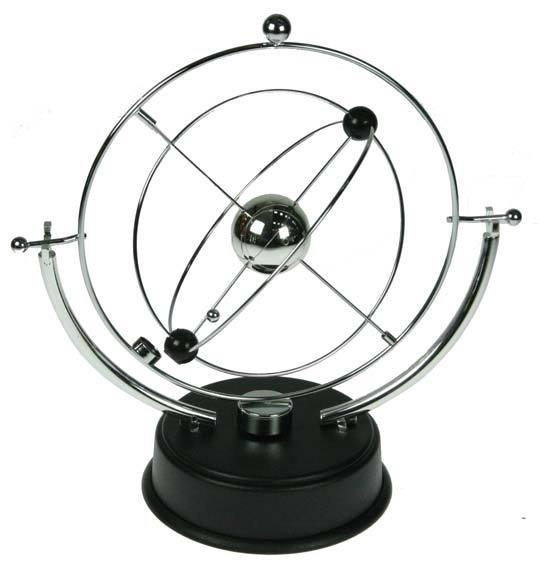
The principle of operation of the device is simple - a magnet, flying over a coil, induces an emf in it, which changes sign at the moment when the magnet begins to move away from the coil. It is on the same principle that I decided to create my device. The important point is that I decided to use the same drive coil as a sensor (and not, for example, another coil, optocoupler or Hall sensor). In other words, the microcontroller (and the design is assembled, of course, on it) first "listens" to the EMF in the coil, and then at the right time connects the same coil to the power supply.
Going from idea to finished device, I had to solve many questions. ATtiny24 came up as a microcontroller. The magnet was chosen as neodymium, in the form of a washer, with a diameter of 15 mm and a thickness of 8 mm. A separate story with a coil - it was necessary to carefully select its parameters, using as well as some theory, as well as several prototype coils with different sizes, wire diameters and number of turns. The geometry and materials of the core also varied. Of course, I wanted to make the magnetic system as closed as possible, ideally, the magnet should move with minimal gaps between the core poles. In this case, the highest efficiency of the device (and hence the minimum amount of copper in the winding) would be achieved. However, for the sake of simplicity of design, high efficiency had to be sacrificed. One of the coil options (not final) is shown in the photo.
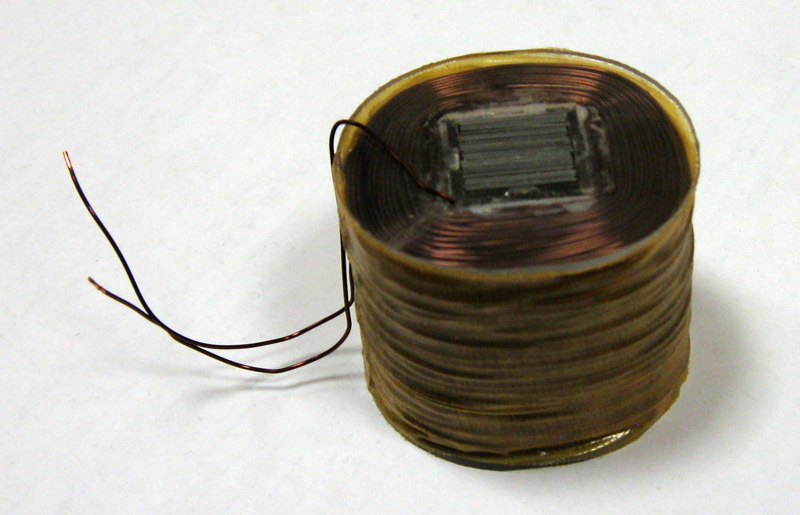
In order for the swing mechanism to move the bed from its place, there was some displacement of the coil relative to the magnet in the equilibrium position.
The remote control was performed using a ready-made Chinese console with four buttons (start, stop, more, less) and a receiver to it. Now using this remote:

In the program for the microcontroller, six rocking speeds were provided (in fact, the length of the pushing pulse changes). For the sixth speed, the algorithm is somewhat more complicated - it uses a series of short pulses with checking the polarity of the induced EMF in the pauses between them. This allows you to achieve maximum energy swing.
During these three years, as new ideas emerge, the program improves. For example, the algorithm for dynamically changing the length of pulses depending on the period of the bed swing was tested (and is being used). An algorithm was also created for a smooth rise and a smooth fall of the current in the drive coil, which determines the complete, absolute noiselessness of the device. Without this improvement, the device still produced some sound during operation, similar to the ticking of a clock. There is also the idea of creating a PI controller with feedback on the amplitude of oscillation, but the problem of determining this amplitude with the help of an existing “sensor” has not yet been solved here.
As the body of the device, the finished Gainta case was chosen, after some time it acquired a beautiful picture engraved with a laser.

Power supply - ready, 12 V, 2 A.
Some more photos of the device:
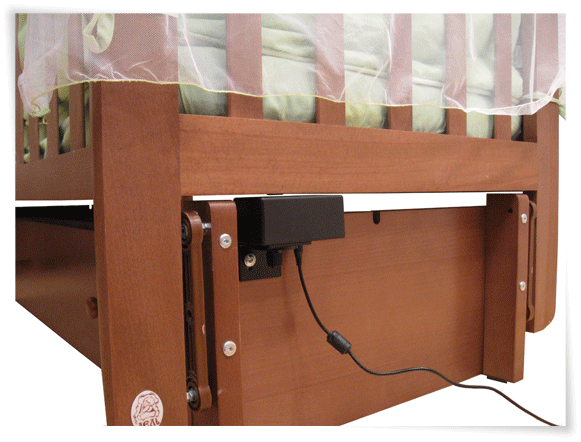

Non-standard fasteners are cut by laser cutting and powder painted.
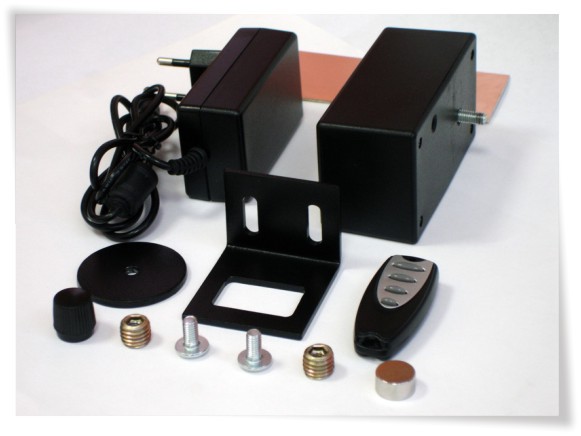
And video:
We used our rocking device for about a year, the wife was very pleased. And then the child refused to be swayed in the crib, and the device turned out to be irrelevant for us.
And then it turned out that such devices can be sold. But that's another story.
If you like this article, I can tell:
- about how I obtained a patent for a utility model, and how it turned out to be practically useless in the actual case of violation of my patent rights;
- about how I began to mass-produce and sell rocking devices, but so far I have not become rich;
- how the device has a new control panel with a screen from the Nokia 1202, as well as additional functions.
Source: https://habr.com/ru/post/240119/
All Articles